Supporting Circular Economy Principles by Recycling Window Frames into Particleboard
Abstract
:1. Introduction
2. Materials and Methods
2.1. Materials
2.2. Preparation of Panels
2.3. Characterization of the Elaborated Panels
2.4. Statistical Analyses
3. Results and Discussion
3.1. Fraction Share and Bulk Density of Particles
3.2. Relative Hardness and Density Profile
3.3. Modulus of Rupture and Modulus of Elasticity
3.4. Internal Bond
3.5. Screw Withdrawal Resistance
3.6. Water Absorption and Thickness Swelling
3.7. Density Profile
3.8. Formaldehyde and TVOC Emission
4. Conclusions
Author Contributions
Funding
Institutional Review Board Statement
Informed Consent Statement
Data Availability Statement
Acknowledgments
Conflicts of Interest
References
- Di Leo, S.; Salvia, M.; Pietrapertosa, F.; Cosmi, C. A Multi-Region Representation of an Automotive Manufacturing Plant with the TIMES Energy Model. In Proceedings of the ECEEE Industrial Summer Study Proceedings, Online Event, 14–17 September 2020; pp. 121–131. Available online: https://www.eceee.org/library/conference_proceedings/eceee_Industrial_Summer_Study/2020/2-sustainable-production-towards-a-circular-economy/a-multi-region-representation-of-an-automotive-manufacturing-plant-with-the-times-energy-model/2020/2-125-20_Di_Leo.pdf/ (accessed on 15 July 2024).
- Koech, M.K.; Munene, K.J. Circular Economy in Kenya; Ghosh, S., Ed.; Springer: Singapore, 2019; ISBN 978-981-15-1051-9. [Google Scholar]
- Atstaja, D.; Uvarova, I.; Kamilla Kambala, D.; Alberte, V.; Stokmane, K.; Gegere-Zetterstroma, A.; Kraze, S.; Zapletnuka, G. Investments to Develop Business Models and Projects in the Circular Economy. IOP Conf. Ser. Earth Environ. Sci. 2020, 578, 012029. [Google Scholar]
- Pantazi-Bajenaru, M.; Georgescu, M.; Alexandrescu, L.; Foiasi, T. Environment Impact of Eco-Engineered Versus Conventional Footwear. In Proceedings of the International Multidisciplinary Scientific GeoConference Surveying Geology and Mining Ecology Management, SGEM, Albena, Bulgaria, 3–9 July 2023; Volume 23, pp. 105–111. [Google Scholar]
- Shahidul, M.I.; Malcolm, M.L.; Hashmi, M.S.J.; Alhaji, M.H. Waste Resources Recycling in Achieving Economic and Environmental Sustainability: Review on Wood Waste Industry. Encycl. Renew. Sustain. Mater. 2020, 1–5, 965–974. [Google Scholar] [CrossRef]
- Järvenpää, A.-M.; Salminen, V.; Ruohomaa, H. How Does Current Legislation Support the Emergence of Industrial Symbiosis in the EU? Adv. Intell. Syst. Comput. 2019, 783, 76–83. [Google Scholar] [CrossRef]
- Niessner, N.P.; Abboud, M.; Wilhelmus, B.; Bradley, C. Circular Economy—New Styrenic Polymer Recycling Concepts. In Proceedings of the Annual Technical Conference—ANTEC, Conference Proceedings, Online, 30 March–5 May 2020; Volume 1, pp. 348–351. [Google Scholar]
- Liao, A. Circular Economy. In Management for Professionals; Springer: Singapore, 2022; Part F527; pp. 375–399. [Google Scholar] [CrossRef]
- Generowicz, N.; Kowalski, Z. Cascade Use of Post-Production Waste from the Wood Industry. Polityka Energ. 2020, 23, 87–102. [Google Scholar] [CrossRef]
- Dragičević, J.S. Use of Biomass for Generation of Thermal Energy. Gradjevinar 2011, 63, 607–610. [Google Scholar]
- Walkowiak, M.; Cichy, W. Recykling and Disposal of Used Wood and Wood Residnes. Drewno 2010, 183, 135–138. [Google Scholar]
- Stelte, W.; Sanadi, A.R.; Shang, L.; Holm, J.K.; Ahrenfeldt, J.; Henriksen, U.B. Recent Developments in Biomass Pelletization—A Review. BioResources 2012, 7, 4451–4490. [Google Scholar] [CrossRef]
- Jafari, V.; Labafzadeh, S.R.; Jeihanipour, A.; Karimi, K.; Taherzadeh, M.J. Construction and Demolition Lignocellulosic Wastes to Bioethanol. Renew. Energy 2011, 36, 2771–2775. [Google Scholar]
- Kharazipour, A.; Kües, U. Recycling of Wood Composites and Solid Wood Products. In Wood Production, Wood Technology, and Biotechnological Impacts; Universitätsverlag Göttingen: Göttingen, Germany, 2007; pp. 509–533. ISBN 978-3-940344-11-3. [Google Scholar]
- Lykidis, C.; Grigoriou, A. Hydrothermal Recycling of Waste and Performance of the Recycled Wooden Particleboards. Waste Manag. 2008, 28, 57–63. [Google Scholar] [CrossRef] [PubMed]
- Coudert, L.; Blais, J.-F.; Mercier, G.; Cooper, P.; Janin, A. Remediation Processes for Wood Treated with Organic and/or Inorganic Preservatives. In Handbook of Recycled Concrete and Demolition Waste; Elsevier: Amsterdam, The Netherlands, 2013. [Google Scholar]
- Shupe, T.F.; Hse, C.Y. Recycling of Preservative-Treated Wood Using Chemical Extraction Technologies. In Environmental Impacts of Treated Wood; CRC/Taylor & Francis: Boca Raton, FL, USA, 2006. [Google Scholar]
- Crespo, A.I.; Raquel, G.; Pérez, V.E.M. URBANREC: New Approaches for the Valorisation of URBAN Bulky Waste into High Added Value Recycled Products. In Proceedings of the 11th Conference on Sustainable Development of Energy, Water and Environment System, Lisbon, Portugal, 4–9 September 2016. [Google Scholar]
- Ratajczak, E.; Szostak, A.; Bidzińska, G.; Herbeć, M. Potential Resources of Post-Consumer Wood Waste in Poland. J. Mater. Cycles Waste Manag. 2018, 20, 402–413. [Google Scholar] [CrossRef]
- Vimpolšek, B.; Mikuljan, M.; Kutnar, A.; Lerher, T.; Potrč, I. Environmentally Waste Management: A Model for Post-Consumer Wood Handling. In Proceedings of the International Conference on Industrial Logistics, ICIL 2014—Conference Proceedings, Bol, Croatia, 11–13 June 2014; pp. 296–305. [Google Scholar]
- Ratajczak, E.; Szostak, A.; Bidzińska, G.; Leszczyszyn, E. Market in Wood By-Products in Poland and Their Flows in the Wood Sector. Drewno 2018, 61, 5–20. [Google Scholar] [CrossRef]
- Çolak, S.; Nemli, G.; Demirkir, C.; Aydin, I.; Demirel, S. Utilization Potential of Waste from Window Joints for Particleboard. J. Compos. Mater. 2011, 45, 29–37. [Google Scholar] [CrossRef]
- Sinha, A.; Kutnar, A. Carbon Footprint versus Performance of Aluminum, Plastic, and Wood Window Frames from Cradle to Gate. Buildings 2012, 2, 542–553. [Google Scholar] [CrossRef]
- Teacă, C.A.; Ignat, M.E.; Nechifor, M.; Tanasă, F.; Ignat, L. In-Soil Degradation of Polymer Materials Waste—A Survey of Different Approaches in Relation with Environmental Impact. BioResources 2023, 18, 2213–2261. [Google Scholar] [CrossRef]
- Nguyen, D.L.; Luedtke, J.; Nopens, M.; Krause, A. Production of Wood-Based Panel from Recycled Wood Resource: A Literature Review. Eur. J. Wood Wood Prod. 2023, 81, 557–570. [Google Scholar] [CrossRef]
- Reinprecht, L.; Baculák, J.; Pánek, M. Natural and Accelerated Ageing of Paints for Wooden Windows. In Acta Facultatis Xylologiae; Technical University in Zvolen: Zvolen, Slovakia, 2011; Volume 53, pp. 21–31. [Google Scholar]
- Castenmiller, C.J.J. Surface Temperature of Wooden Window Frames under Influence of Solar Radiation. Heron 2004, 49, 339–348. [Google Scholar]
- Pasco, H.; Lesaine, A.; Cerasuolo, A.; Boissière, C.; Walter, P.; Sanchez, C.; de Viguerie, L.; Faustini, M. In Situ Infrared and UV–Vis Ellipsometries to Probe the Varnish Ageing and Swelling of G. Bellini “Transfiguration”. Adv. Mater. Interfaces 2024, 11, 2300563. [Google Scholar] [CrossRef]
- Llana, D.F.; González-Alegre, V.; Portela, M.; García-Navarro, J.; Íñiguez-González, G. Engineered Wood Products Manufactured from Reclaimed Hardwood Timber. In Proceedings of the 13th World Conference on Timber Engineering, WCTE 2023, Oslo, Norway, 19–22 June 2023; Volume 6, pp. 3594–3599. [Google Scholar]
- Irle, M.; Privat, F.; Couret, L.; Belloncle, C.; Déroubaix, G.; Bonnin, E.; Cathala, B. Advanced Recycling of Post-Consumer Solid Wood and MDF. Wood Mater. Sci. Eng. 2019, 14, 19–23. [Google Scholar] [CrossRef]
- InFutURe Wood. Available online: https://www.infuturewood.info/ (accessed on 12 July 2024).
- Recowers. Available online: https://recowers.wordpress.com/ (accessed on 11 July 2024).
- Kamdem, D.P. Recycling of Wood Treated with Chromated Copper Arsenate into Composite Construction Materials; Townsend, T.G., Solo-Gabriele, H., Eds.; CRC Press: Boca Raton, FL, USA, 2006; ISBN 9780429116506. [Google Scholar]
- EGGER. Available online: https://www.egger.com/pl/news/egger-biskupiec-rozwija-recykling-drewna?country=PL (accessed on 10 July 2024).
- Teischinger, A.; Kalcher, J.; Salzger, E.; Praxmarer, G.; Vanek, M. General Systematic for a Design for Recycling-Guideline for Wooden Windows and Wood Aluminium Windows. In Proceedings of the WCTE 2016—World Conference on Timber Engineering, Vienna, Austria, 22–25 August 2016. [Google Scholar]
- Rios, F.C.; Grau, D.; Chong, W.K. Steel or Wood Frame? A Life Cycle Comparison of External Wall Systems through Deconstruction and Reuse. In Proceedings of the Construction Research Congress 2018: Sustainable Design and Construction and Education—Selected Papers from the Construction Research Congress 2018, New Orleans, LA, USA, 2–4 April 2018; pp. 482–492. [Google Scholar]
- Lesar, B.; Humar, M.; Hora, G. Quality Assessment of Recycled Wood with and without Non-Wooden Materials from Selected Recycling Companies in Europe. Waste Manag. 2018, 79, 362–373. [Google Scholar] [CrossRef]
- Lesar, B.; Humar, M.; Hora, G.; Hachmeister, P.; Schmiedl, D.; Pindel, E.; Siika-aho, M.; Liitiä, T. Utilization of Recycled Wood in Biorefineries: Preliminary Results of Steam Explosion and Ethanol/Water Organosolv Pulping without a Catalyst. Eur. J. Wood Wood Prod. 2016, 74, 711–723. [Google Scholar] [CrossRef]
- EN 827; Adhesives—Determination of Conventional Solids Content and Constant Mass Solids Content. European Committee for Standardization: Brussels, Belgium, 2005.
- ISO 1522; Paints and Varnishes—Pendulum Damping Test. European Committee for Standardization: Brussels, Belgium, 2022.
- EN 323; Wood-Based Panels—Determination of Density. European Committee for Standardization: Brussels, Belgium, 1993.
- EN 310; Wood-Based Panels. Determination of Modulus of Elasticity in Bending and of Bending Strength. European Committee for Standardization: Brussels, Belgium, 1993.
- EN 319; Particleboards and Fibreboards. Determination of Tensile Strength Perpendicular to the Plane of the Board. European Committee for Standardization: Brussels, Belgium, 1993.
- EN 320; Particleboards and Fibreboards—Determination of Resistance to Axial Withdrawal of Screws. European Committee for Standardization: Brussels, Belgium, 2011.
- EN 317; Particleboards and Fibreboards—Determination of Swelling in Thickness after Immersion in Water. European Committee for Standardization: Brussels, Belgium, 1993.
- EN 312; Particleboards—Specifications. European Committee for Standardization: Brussels, Belgium, 2010.
- Wronka, A.; Kowaluk, G. The Influence of Multiple Mechanical Recycling of Particleboards on Their Selected Mechanical and Physical Properties. Materials 2022, 15, 8487. [Google Scholar] [CrossRef]
- Wojciechowska, M.; Kowaluk, G. Waste Banana Peel Flour as a Filler in Plywood Binder. Ann. Wars. Univ. Life Sci.-SGGW For. Wood Technol. 2023, 123, 143–152. [Google Scholar] [CrossRef]
- Wronka, A.; Kowaluk, G. Upcycling Different Particle Sizes and Contents of Pine Branches into Particleboard. Polymers 2022, 14, 4559. [Google Scholar] [CrossRef]
- Zalewska, A.; Kowalik, J.; Tworek, M. Investigation of the Properties of a Water-Based Acrylic Dispersion Modified with an Ionic Liquid, Surfactant, and Thickener. Environ. Sci. Pollut. Res. 2023. [Google Scholar] [CrossRef]
- Çakicier, N.; Korkut, S.; Sevim Korkut, D. Varnish Layer Hardness, Scratch Resistance, and Glossiness of Various Wood Species as Affected by Heat Treatment. BioResources 2011, 6, 1648–1658. [Google Scholar] [CrossRef]
- Kaygin, B.; Akgun, E. Comparison of Conventional Varnishes with Nanolacke UV Varnish with Respect to Hardness and Adhesion Durability. Int. J. Mol. Sci. 2008, 9, 476–485. [Google Scholar] [CrossRef] [PubMed]
- Aksu, S.; Kelleci, O.; Aydemir, D.; Istek, A. Application of Acrylic-Based Varnishes Reinforced with Nano Fillers for Conservation of Weathered and Worn Surfaces of the Historical and Cultural Wooden Buildings. J. Cult. Herit. 2022, 54, 1–11. [Google Scholar] [CrossRef]
- Saranjam, N.; Chandra, S.; Mostaghimi, J.; Fan, H.; Simmer, J. Orange Peel Formation Due to Surface Tension-Driven Flows within Drying Paint Films. J. Coat. Technol. Res. 2016, 13, 413–426. [Google Scholar] [CrossRef]
- Palija, T.; Jaić, M.; Džinčić, I.; Šućur, A.; Dobić, J. Variability of Dry Film Thickness of a Coating Applied by Roller Coater on Wood in a Real Industrial Process. Drewno 2018, 61, 153–164. [Google Scholar] [CrossRef]
- Dvořák, O.; Pánek, M.; Kvietková, M.S.; Pastierovič, F.; Štěrbová, I.; Kubista, K.; Sahula, L. Influence of Wood Species on Quality of Exterior Transparent Acrylic Coating During Outdoor Exposure. Wood Res. 2022, 67, 994–1004. [Google Scholar] [CrossRef]
- Onat, S.M.; Coşkun, K.; Kelleci, O. Particleboard Density and Surface Quality. In Proceedings of the 2nd International Conference on Contemporary Academic Research, Konya, Türkiye, 4–5 November 2023. [Google Scholar]
- Iždinský, J.; Vidholdová, Z.; Reinprecht, L. Particleboards from Recycled Wood. Forests 2020, 11, 1166. [Google Scholar] [CrossRef]
- Martins, J.; Pereira, J.; Pinto, B.; Coelho, C. Effect of Recycled Wood on Formaldehyde Release of Particleboard. In Proceedings of the COST Action E49 Conference “Measurement and Control of VOC Emissions from Wood-Based Panels”, Braunschweig, Germany, 28–29 November 2007; p. 10. [Google Scholar]
- Iždinský, J.; Vidholdová, Z.; Reinprecht, L. Particleboards from Recycled Thermally Modified Wood. Forests 2021, 12, 1462. [Google Scholar] [CrossRef]
- Borysiuk, P.; Chrzanowski, Ł.; Auriga, R.; Boruszewski, P. Thermally Modified Particles as Raw Material for Particleboards Production. In Proceedings of the Chip and Chipless Woodworking Processes Conference, Tatranska Lomnica, Slovakia, 8–9 September 2016; pp. 241–245. [Google Scholar]
- Wronka, A.; Kowaluk, G. Influence of Density on Selected Properties of Furniture Particleboards Made of Raspberry Rubus Idaeus L. Lignocellulosic Particles. Ann. Wars. Univ. Life Sci.-SGGW For. Wood Technol. 2019, 105, 62–70. [Google Scholar] [CrossRef]
- Wong, E.D.; Zhang, M.; Wang, Q.; Han, G.; Kawai, S. Formation of the Density Profile and Its Effects on the Properties of Fiberboard. J. Wood Sci. 2000, 46, 202–209. [Google Scholar] [CrossRef]
- Lubis, M.A.R.; Hong, M.K.; Park, B.D.; Lee, S.M. Effects of Recycled Fiber Content on the Properties of Medium Density Fiberboard. Eur. J. Wood Wood Prod. 2018, 76, 1515–1526. [Google Scholar] [CrossRef]
- Sackey, E.K.; Semple, K.E.; Oh, S.-W.; Smith, G.D. Improving Core Bond Strength of Particleboard through Particle Size Redistribution. Wood Fiber Sci. 2008, 40, 214–224. [Google Scholar]
- Wronka, A.; Kowaluk, G. Selected Properties of Particleboard Made of Raspberry Rubus Idaeus L. Lignocellulosic Particles. Ann. Wars. Univ. Life Sci.-SGGW For. Wood Technol. 2019, 105, 113–124. [Google Scholar] [CrossRef]
- Taghiyari, H.R.; Ghamsari, F.A.; Salimifard, E. Effects of Adding Nano-Wollastonite, Date Palm Prunings and Two Types of Resins on the Physical and Mechanical Properties of Medium-Density Fibreboard (MDF) Made from Wood Fibres. Bois For. Des Trop. 2018, 335, 49–57. [Google Scholar] [CrossRef]
- Luo, P.; Yang, C.; He, Y.; Wang, T. Use of Scrap Particleboard to Produce Recycled Particleboard. BioResources 2024, 19, 3837–3844. [Google Scholar] [CrossRef]
- Riegler, M.; Weigl, M.; Harm, M.; Rathke, J.; Müller, U. Influence of Hardwood on the Vertical Density Profile and Fracture Energy of Particleboards. In Proceedings of the Hardwood Sci. Technol. 5th Conf. Hardwood Res. Util. Eur., Sopron, Hungary, 10–11 September 2012; pp. 3–7, ISBN 978-963-9883-97-0. [Google Scholar]
- Wronka, A.; Robles, E.; Kowaluk, G. Upcycling and Recycling Potential of Selected Lignocellulosic Waste Biomass. Materials 2021, 14, 7772. [Google Scholar] [CrossRef]
- Sung, M.; Lee, S.-M.; Min, Y. Decreasing the Formaldehyde Concentration in Indoor Air by Improving the Adhesives Used in Engineered Wood Materials in Korean Apartment Buildings. J. Adhes. Sci. Technol. 2013, 27, 671–682. [Google Scholar] [CrossRef]
- Meng, M.; Hong, W. Mathematical Model for the Formaldehyde Emission from Wood Composites. For. Prod. J. 2017, 67, 126–134. [Google Scholar] [CrossRef]
- Szczurek, A.; Zajiczek, Ż.; Sibilak, D.; Maciejewska, M. Formaldehyde Removal by the Internal Wall Paint—Preliminary Study. In Proceedings of the E3S Web of Conferences, Polanica-Zdrój, Poland, 16–18 April 2018; Volume 44. [Google Scholar] [CrossRef]
- Chen, W.; Mendell, M.; Li, N.; Kumagai, K. Formaldehyde Emissions from Seams and Cut Edges of Laminate Flooring: Implications for Emission Testing Protocols and Exposure Estimation. Build. Environ. 2018, 143, 652–660. [Google Scholar] [CrossRef]
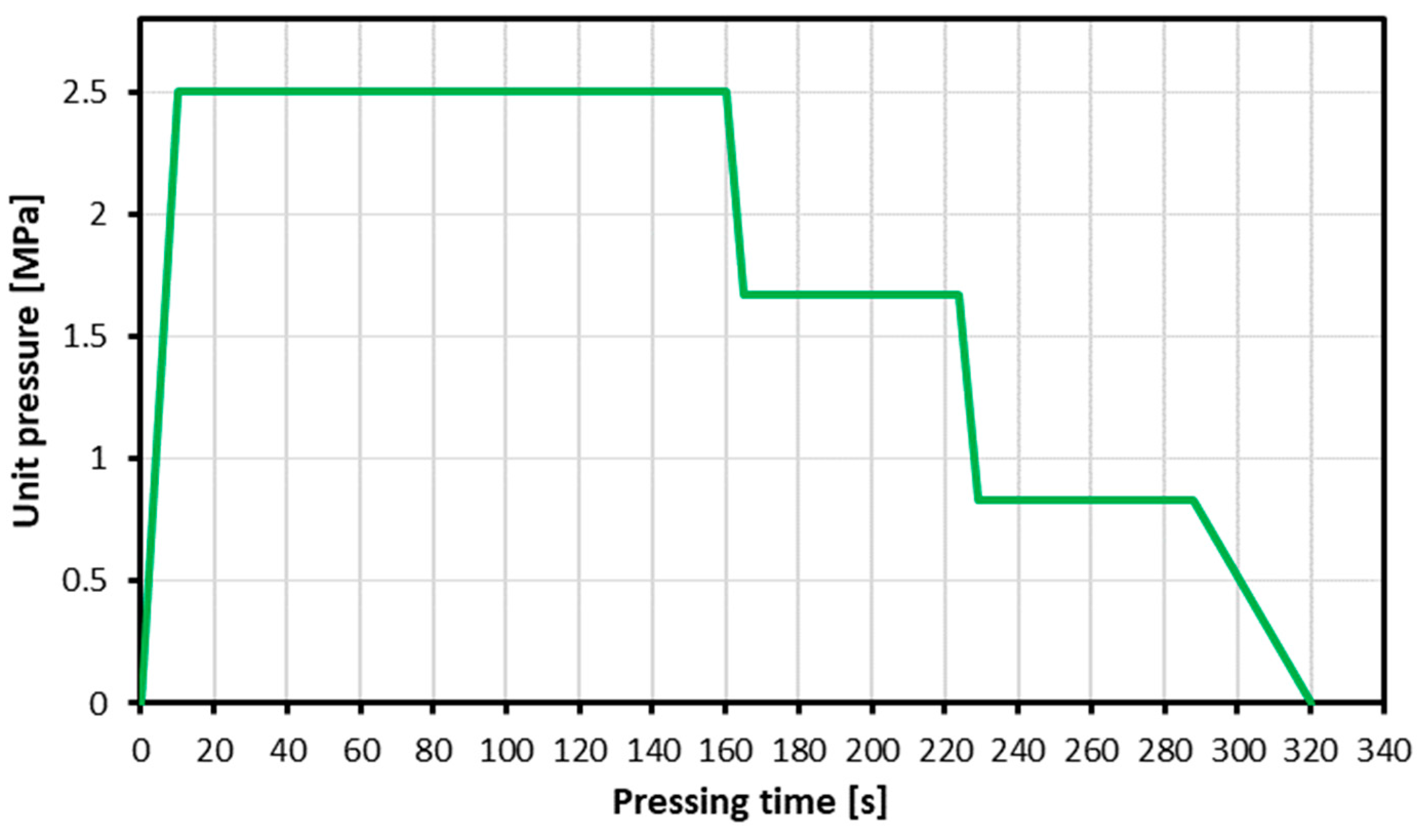
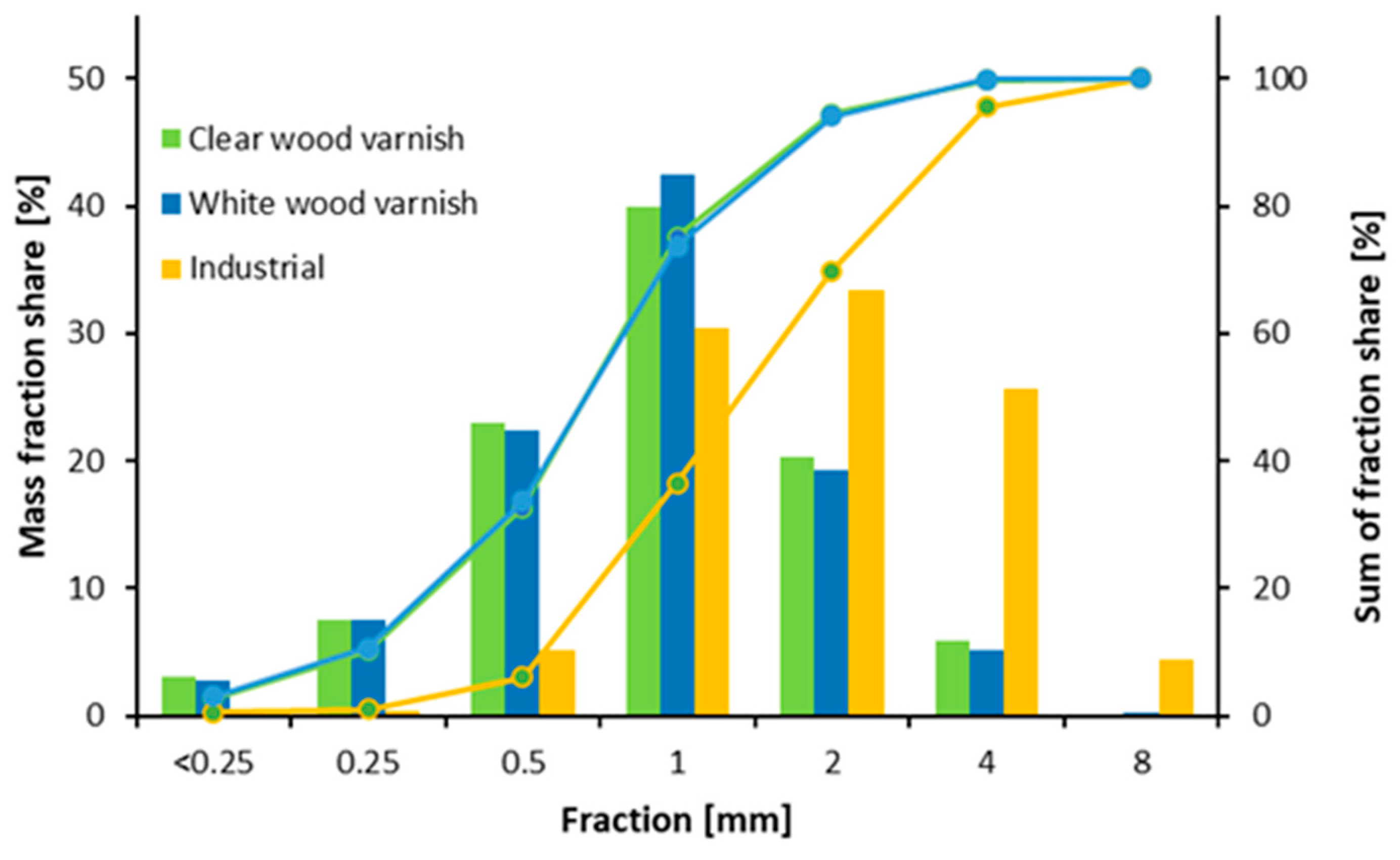
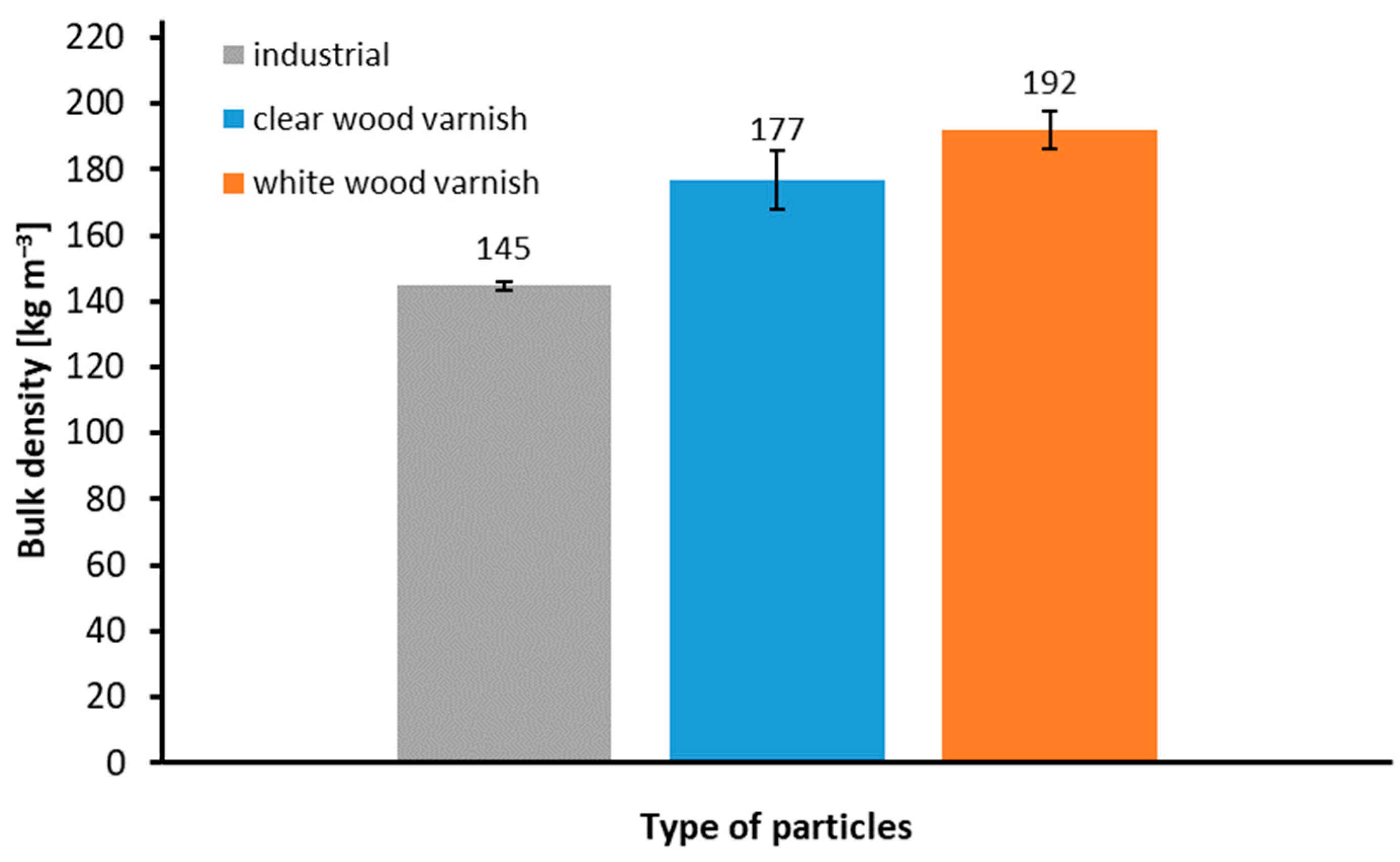
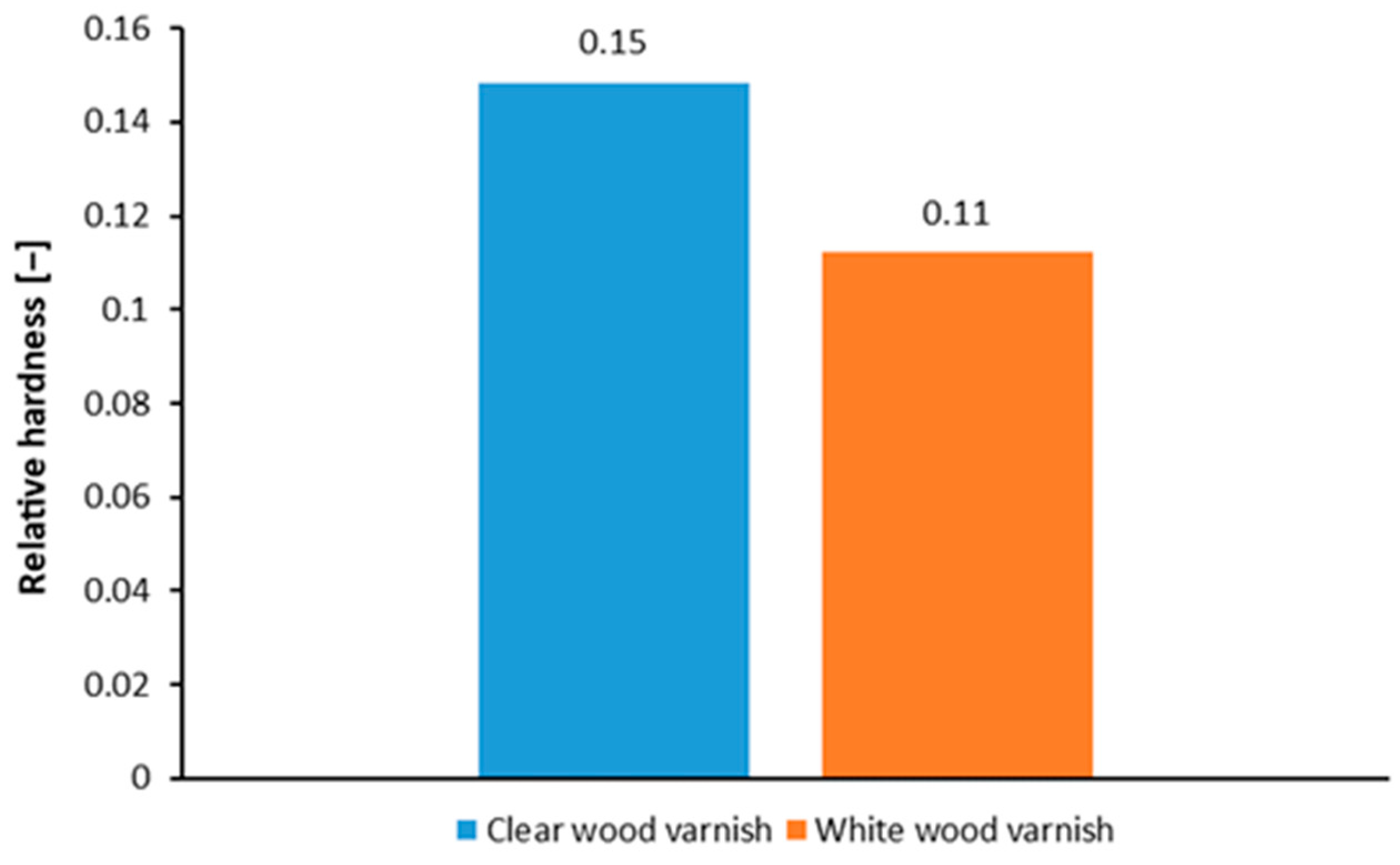
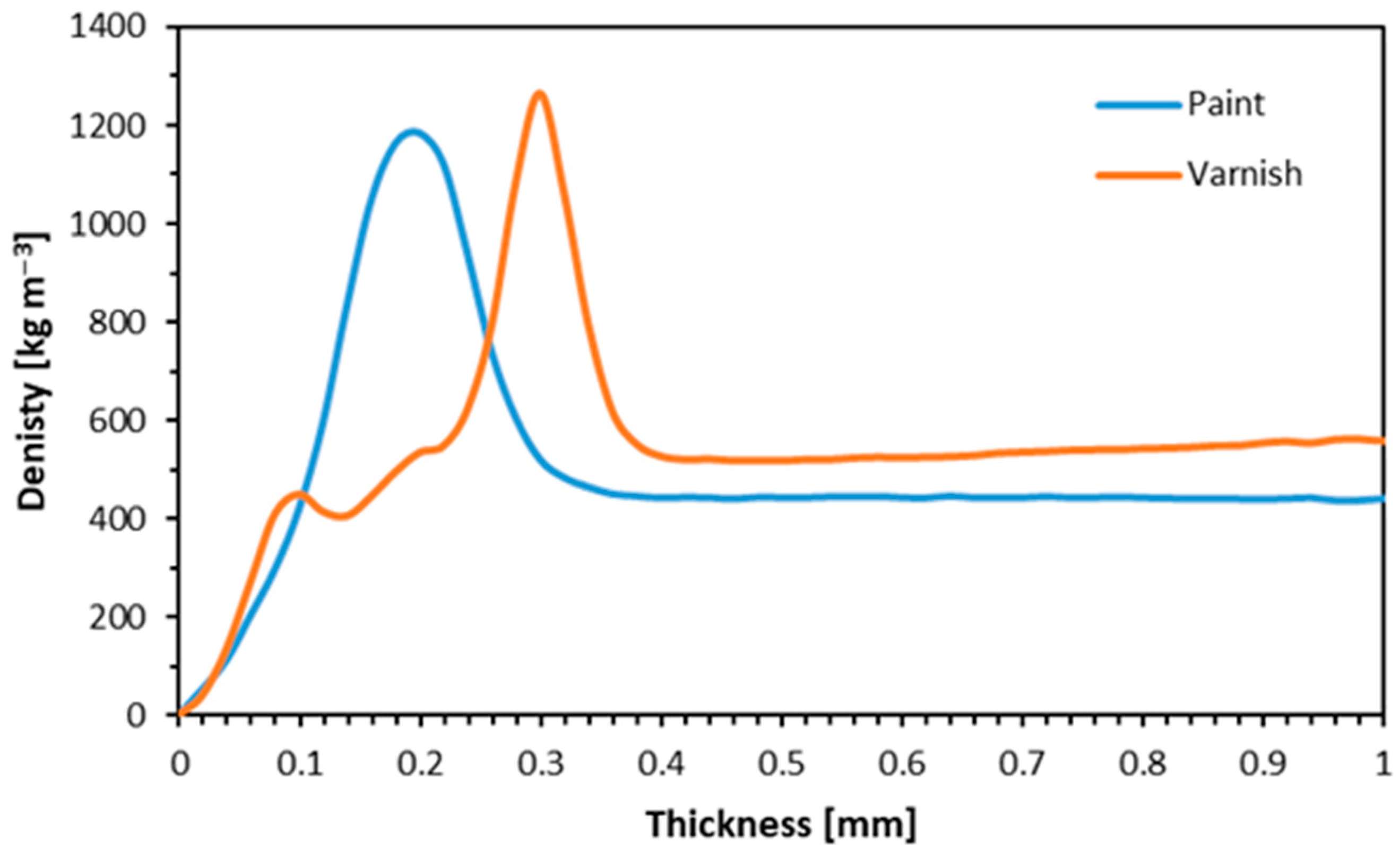
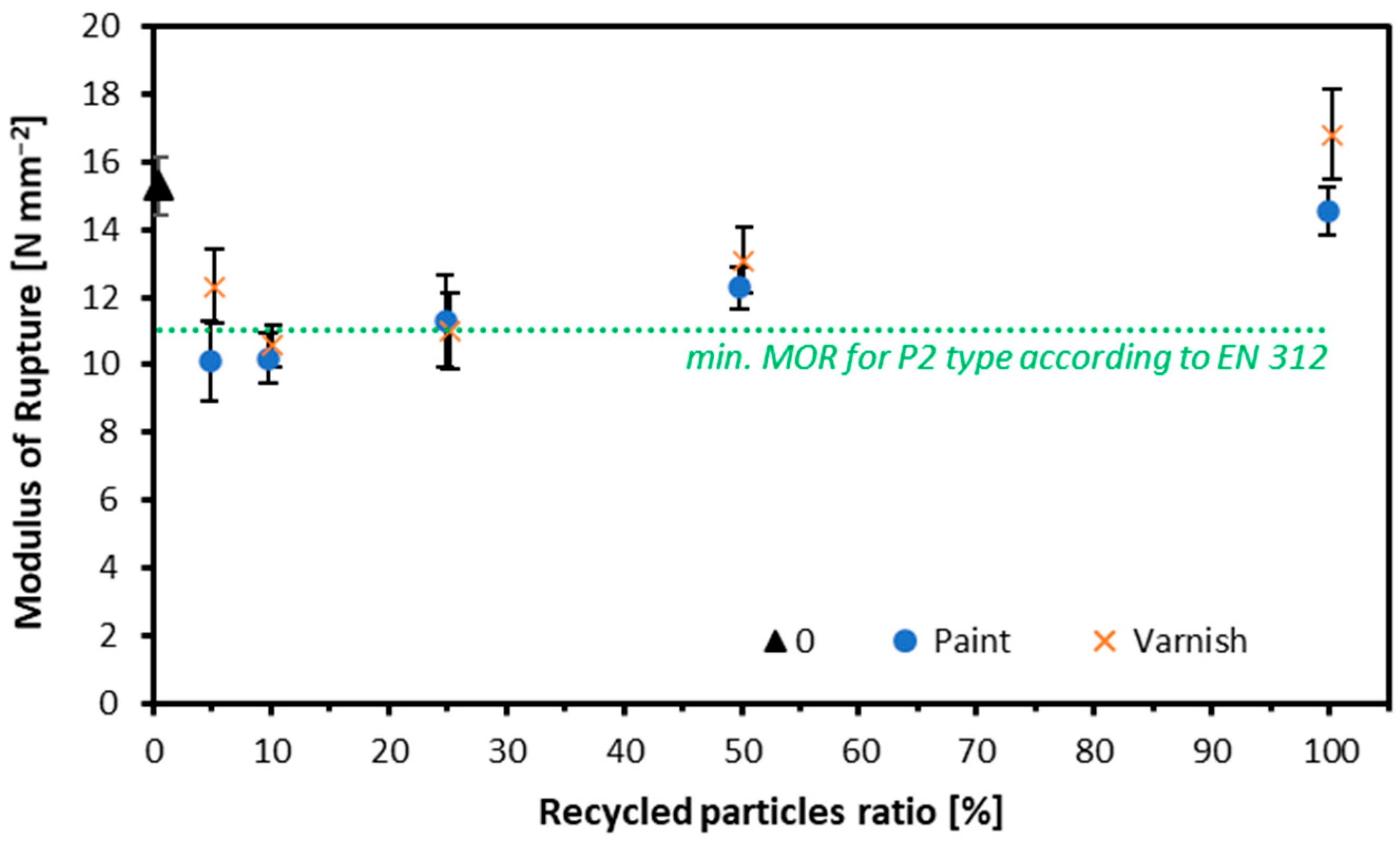
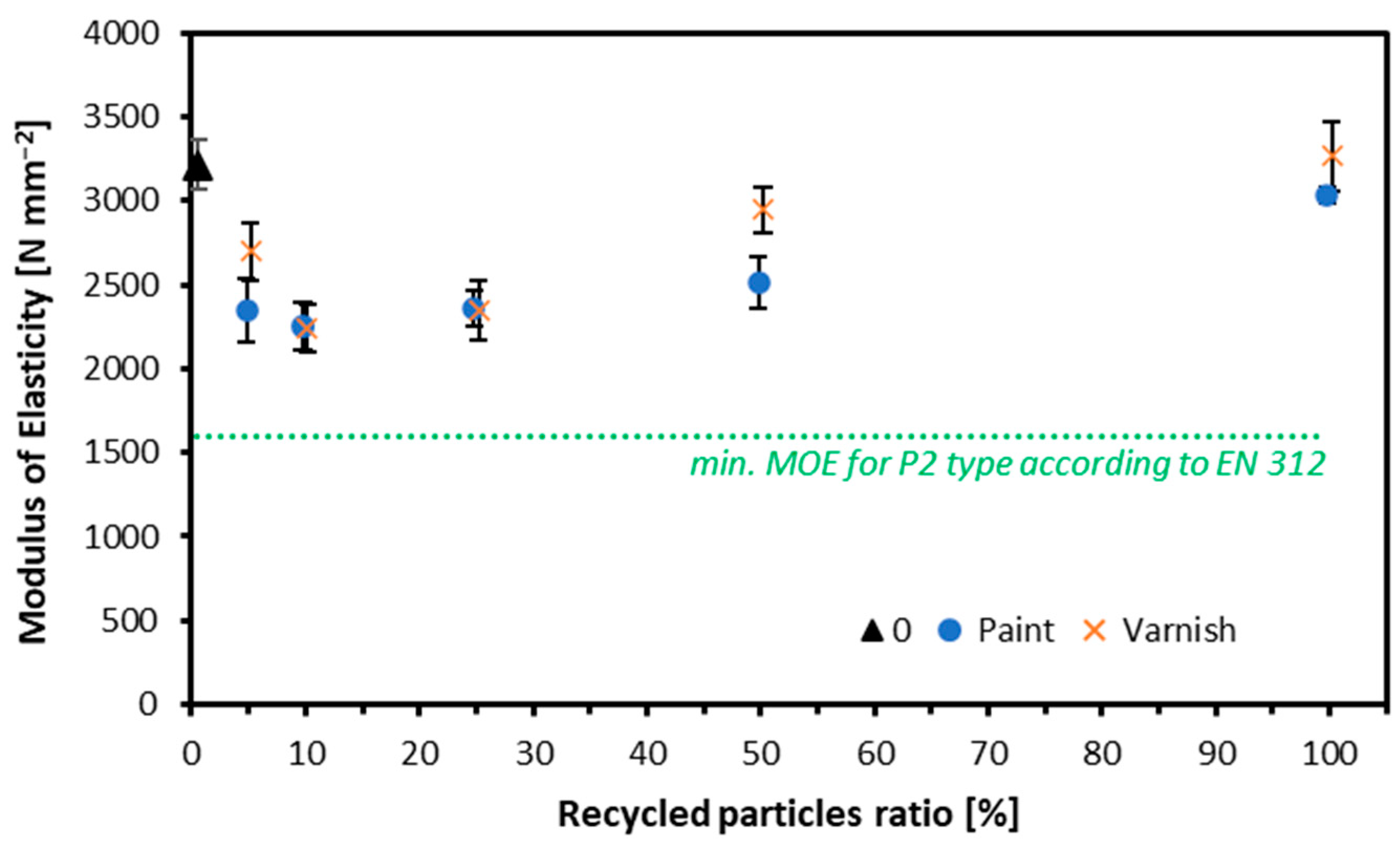

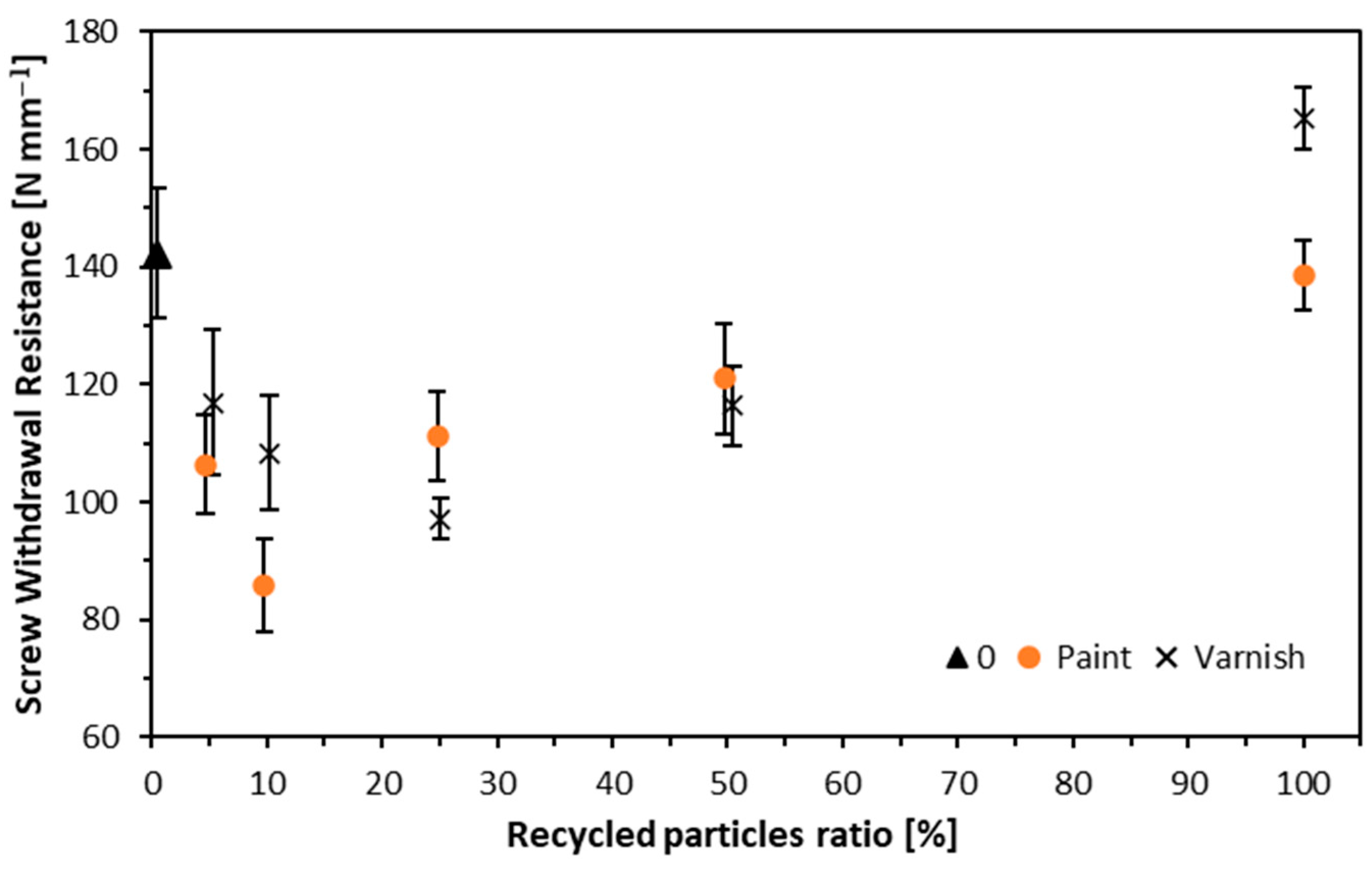

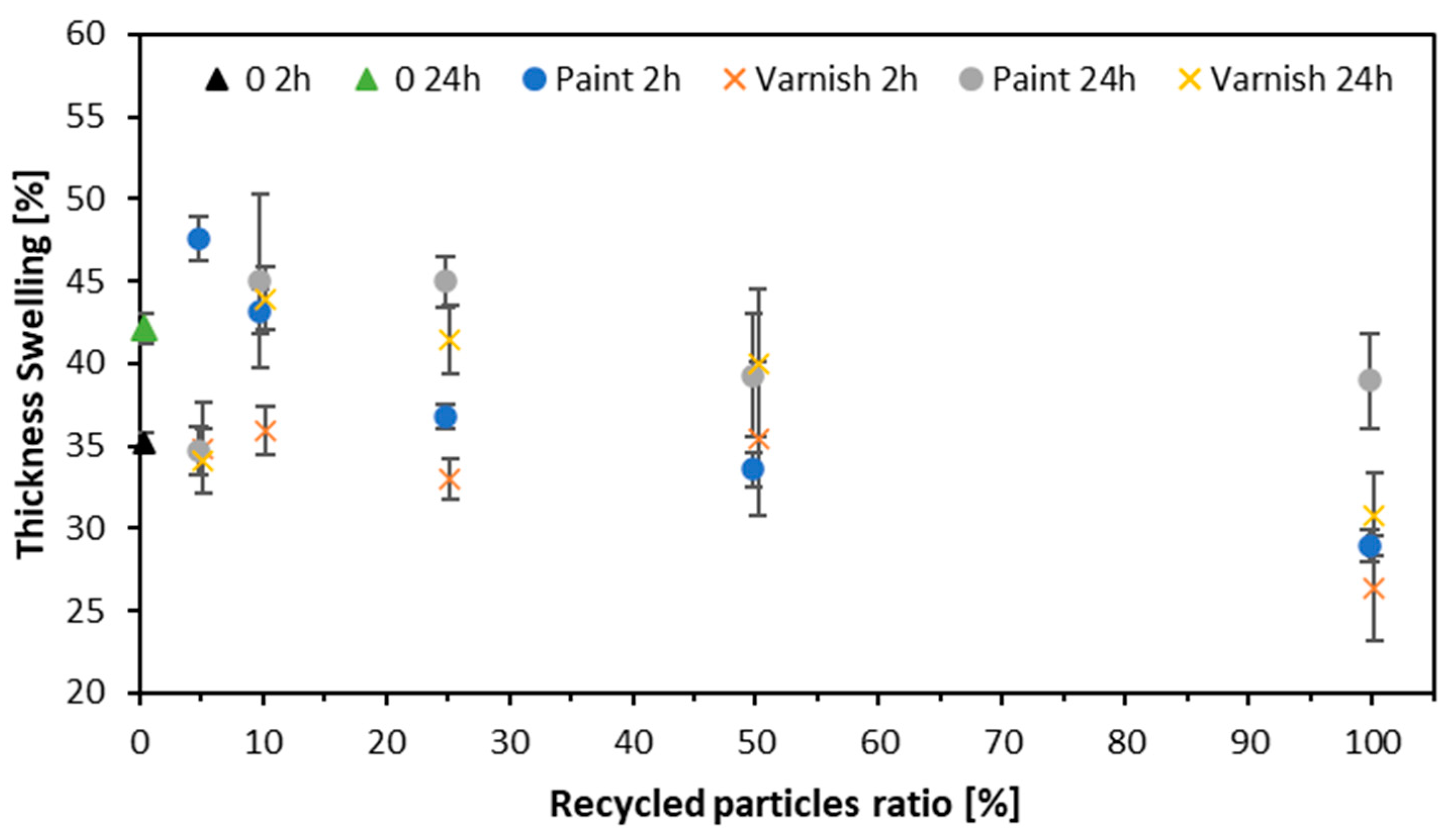
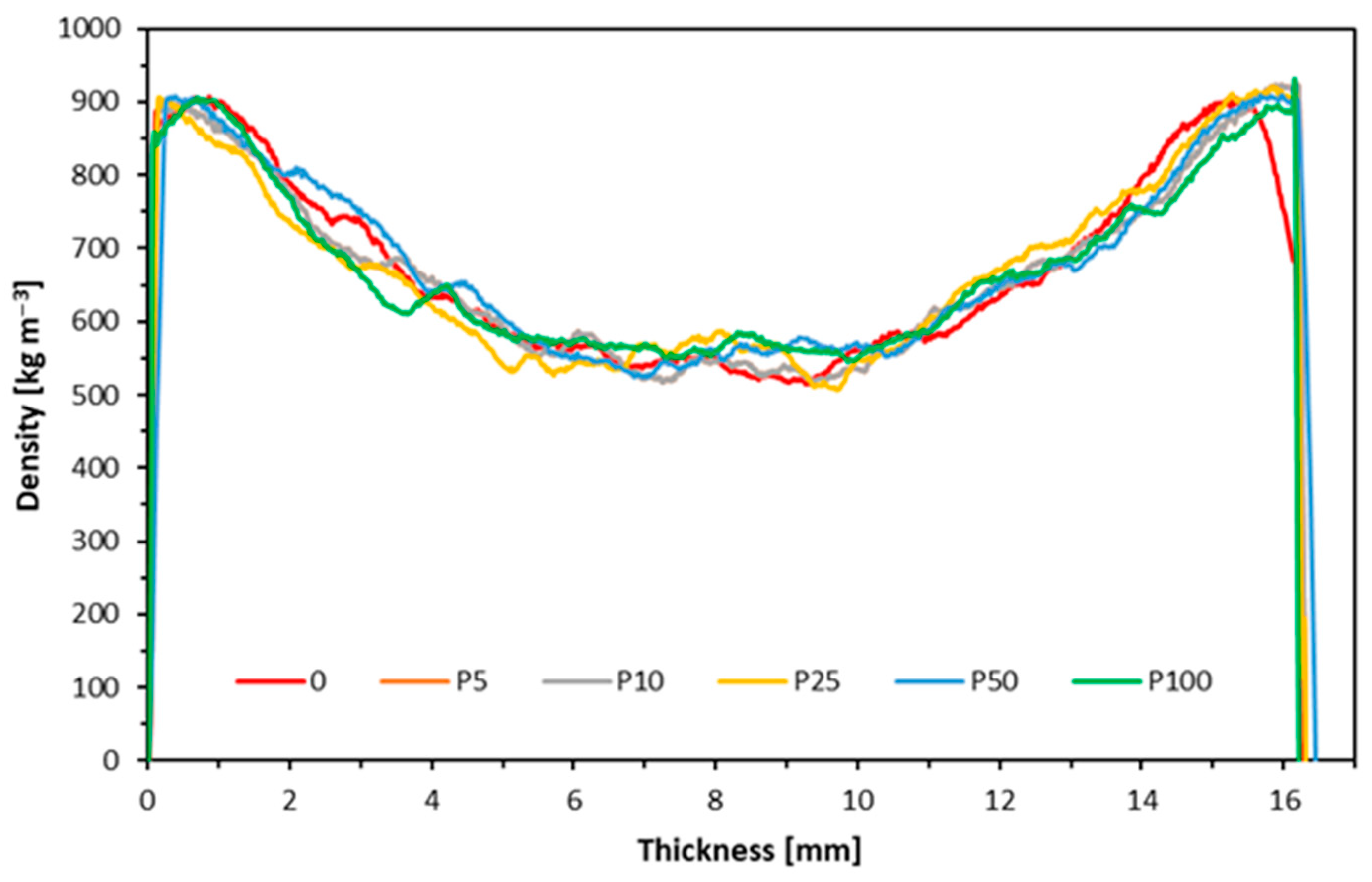
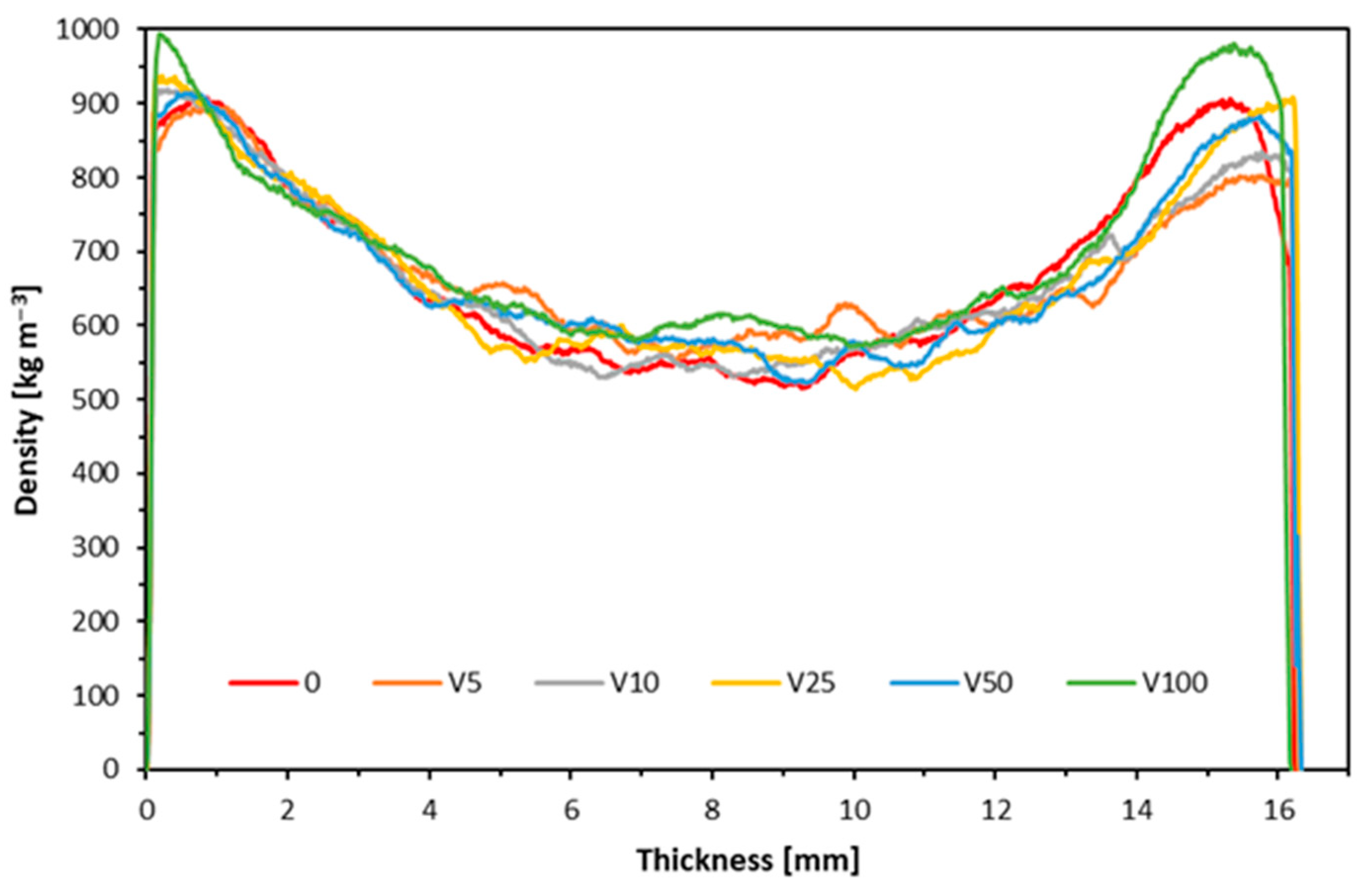

| Test Type | Alternative Raw Material Particles Share [%] | ||||||||||
|---|---|---|---|---|---|---|---|---|---|---|---|
| 0 | 5 | 10 | 25 | 50 | 100 | ||||||
| V | P | V | P | V | P | V | P | V | P | ||
| MOE [N mm−2] | 3212 a 1 (146) 2 | 2697 b (169) | 2344 c (186) | 2241 c (140) | 2251 c (138) | 2350 c (177) | 2357 c (108) | 2949 b (136) | 2511 c (158) | 3265 a (207) | 3032 b (43) |
| MOR [N mm−2] | 15.3 a (0.9) | 12.3 b (1.1) | 10.1 c (1.2) | 10.6 b (0.6) | 10.2 b (0.7) | 11.0 b,c (1.1) | 11.3 b,c (1.3) | 13.1 b (1.0) | 12.3 b (0.6) | 16.8 a (1.3) | 14.5 a (0.7) |
| IB [N mm−2] | 0.61 a (0.04) | 0.23 b (0.03) | 0.16 c (0.03) | 0.13 c (0.02) | 0.09 d (0.01) | 0.23 b (0.03) | 0.17 c (0.01) | 0.30 e (0.02) | 0.19 b (0.01) | 0.89 f (0.08) | 0.47 g (0.03) |
| SWR [N mm−1] | 142 a (11) | 117 b (12) | 106 b (9) | 108 b (10) | 86 c (8) | 97 b (4) | 111 b (8) | 116 b (7) | 121 b (9) | 116 d (7) | 139 a (6) |
| TS 2 h [%] | 35.2 a (0.6) | 34.9 a (2.8) | 47.6 a (1.4) | 35.9 a (1.5) | 43.1 b (1.3) | 33.0 c (1.3) | 36.8 a (0.7) | 35.5 a (4.7) | 33.5 b (1.0) | 26.3 d (3.2) | 28.9 d (1.0) |
| TS 24 h [%] | 42.2 a (0.9) | 34.1 b (1.9) | 34.7 b (1.5) | 43.9 a (1.9) | 45.0 a (5.3) | 41.5 a (2.1) | 45.0 c (1.6) | 40.0 a,b (4.5) | 39.3 a,b (3.7) | 30.8 d (2.5) | 38.9 a,b (2.9) |
| WA 2 h [%] | 87.4 a (1.6) | 85.8 a,b (1.5) | 84.4 b (1.5) | 82.2 c (0.3) | 82.3 b,c (1.4) | 80.3 d (0.6) | 78.8 d (1.0) | 80.3 c (2.3) | 75.5 e (1.4) | 72.0 f (1.5) | 71.4 f (2.2) |
| WA 24 h [%] | 94.1 a (0.8) | 80.6 b (3.6) | 76.5 b (1.1) | 90.5 c (0.2) | 90.6 c (1.9) | 89.6 c (0.4) | 89.5 c (1.3) | 86.2 d (1.2) | 87.1 d (0.5) | 78.2 b (1.6) | 85.7 d (3.5) |
| HCHO [mg m−3] | 0.073 a (0.005) | n.b.t. 3 | n.b.t. | n.b.t. | n.b.t. | n.b.t. | n.b.t. | n.b.t. | n.b.t. | 0.075 a (0.005) | 0.076 a (0.009) |
| TVOC [mg m−3] | 0.087 a (0.006) | n.b.t. | n.b.t. | n.b.t. | n.b.t. | n.b.t. | n.b.t. | n.b.t. | n.b.t. | 0.094 a (0.015) | 0.089 a (0.010) |
Disclaimer/Publisher’s Note: The statements, opinions and data contained in all publications are solely those of the individual author(s) and contributor(s) and not of MDPI and/or the editor(s). MDPI and/or the editor(s) disclaim responsibility for any injury to people or property resulting from any ideas, methods, instructions or products referred to in the content. |
© 2024 by the authors. Licensee MDPI, Basel, Switzerland. This article is an open access article distributed under the terms and conditions of the Creative Commons Attribution (CC BY) license (https://creativecommons.org/licenses/by/4.0/).
Share and Cite
Wronka, A.; Kowaluk, G. Supporting Circular Economy Principles by Recycling Window Frames into Particleboard. Materials 2024, 17, 4132. https://doi.org/10.3390/ma17164132
Wronka A, Kowaluk G. Supporting Circular Economy Principles by Recycling Window Frames into Particleboard. Materials. 2024; 17(16):4132. https://doi.org/10.3390/ma17164132
Chicago/Turabian StyleWronka, Anita, and Grzegorz Kowaluk. 2024. "Supporting Circular Economy Principles by Recycling Window Frames into Particleboard" Materials 17, no. 16: 4132. https://doi.org/10.3390/ma17164132





